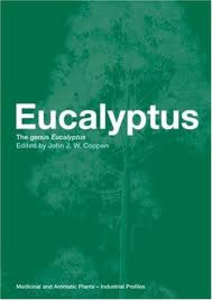Chemical ecology of herbivory in Eucalyptus: interactions between insect and mammalian herbivores and plant essential oils
Lawler, Ivan R., and Foley, William J. (2002) Chemical ecology of herbivory in Eucalyptus: interactions between insect and mammalian herbivores and plant essential oils. In: Coopen, John J.W., (ed.) Eucalyptus: the genus Eucalyptus. Medicinal and Aromatic Plants - industrial profiles, 22 . CRC Press, London, UK, pp. 324-344.
|
PDF (Published Version)
- Published Version
Restricted to Repository staff only |
||
![[img]](https://researchonline.jcu.edu.au/14372/2.hassmallThumbnailVersion/14372_Lawler_%26_Foley_2002.jpg)
|
Image (JPEG) (Front Cover)
- Cover Image
Download (6kB) |
Abstract
[Extract] Eucalyptus dominates more than 90 per cent of Australian forests and woodlands and supports a wide range of endemic vertebrates and invertebrates. Nonetheless, few insects, and even fewer mammals, eat the foliage to any appreciable extent (Landsberg and Cork 1997). Eucalyptus foliage contains low amounts of dietary nitrogen, which is essential for the maintenance and reproduction of all animals (Cork and Foley 1991), but also appreciable amounts of essential oils and phenolic compounds. Both these groups of compounds are believed to have a significant influence on the acceptability of foliage as food and the nutritional quality of that foliage (Hume 1982).
There has long been speculation about the degree and nature of the influence of Eucalyptus oils on the food choice of herbivores. This interest has been driven by a number of considerations. Firstly, the restricted diet of koalas suggests that a knowledge of its nutrition and food choices will contribute substantially to its conservation and the conservation of other sympatric species (Cork and Sanson 1990).
Secondly, efforts to establish plantations of Eucalyptus for wood fibre and sawn timber are plagued by the damage inflicted on plants by pest insects and mammals (Montague 1994, Patterson et al. 1996). Although this is countered by extensive poisoning campaigns, current research is seeking to incorporate naturally resistant genotypes into plantation management systems (Farrow 1993). Determining the role of essential oils and related compounds in conferring resistance to herbivores has substantial economic consequences.
Finally, the dominance of Eucalyptus in the Australian environment, a variable level of herbivory and the substantial quantities of plant secondary metabolites contained in the foliage, has spurred a number of studies seeking a more fundamental understanding of the evolutionary interactions between plants and herbivores (Morrow and Fox 1980, Morrow et al. 1976, Cork and Foley 1991). For example, Morrow and Fox (1980) used Eucalyptus and its volatile oils to test whether herbivory was controlled by the metabolic costs of detoxification. These types of studies have made important contributions to broader ecological theory.
In this chapter, we review studies which have examined the role of Eucalyptus oils in determining the feeding of Australian insects and mammals or which have measured the consequences of ingested oils. We conclude by evaluating the role of essential oils in conferring natural herbivore resistance on Eucalyptus and the prospects of selecting high yielding genotypes for use in breeding programmes.
| Item ID: | 14372 |
|---|---|
| Item Type: | Book Chapter (Research - B1) |
| ISBN: | 978-0-203-21943-0 |
| Keywords: | eucalyptus; insect; mammalian herbivores |
| Related URLs: | |
| Date Deposited: | 08 Dec 2010 01:20 |
| FoR Codes: | 06 BIOLOGICAL SCIENCES > 0603 Evolutionary Biology > 060399 Evolutionary Biology not elsewhere classified @ 60% 06 BIOLOGICAL SCIENCES > 0602 Ecology > 060206 Palaeoecology @ 40% |
| SEO Codes: | 96 ENVIRONMENT > 9608 Flora, Fauna and Biodiversity > 960806 Forest and Woodlands Flora, Fauna and Biodiversity @ 100% |
| Downloads: |
Total: 439 Last 12 Months: 6 |
| More Statistics |



